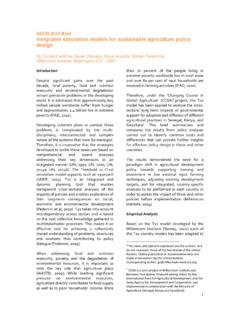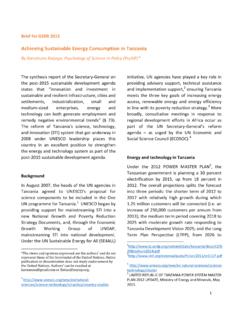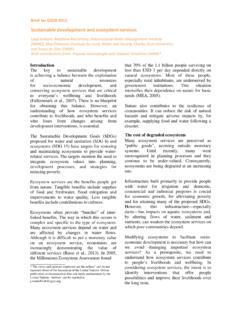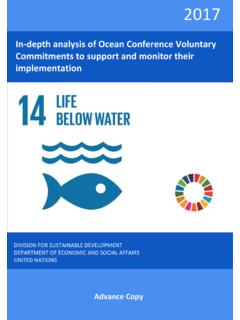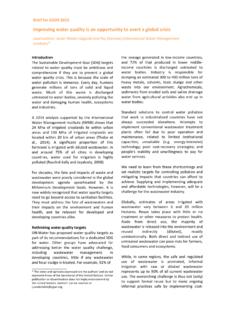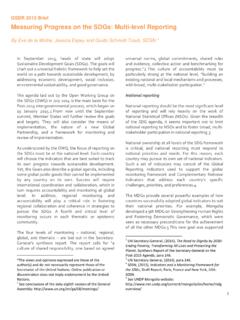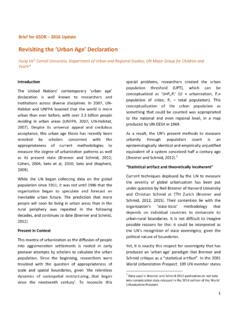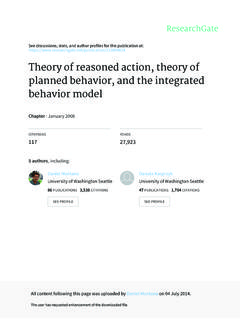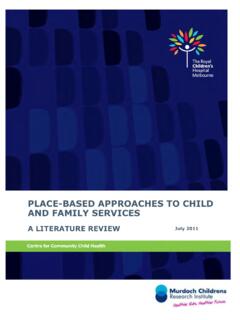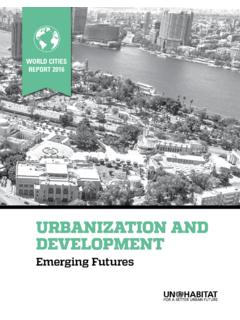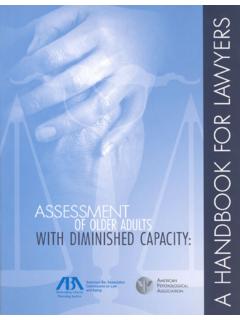Transcription of 130918 SDSN Why the World Needs an Urban SDG
1 WHY THE World Needs AN Urban SUSTAINABLE DEVELOPMENT GOAL1 September 18, 2013 In June 2013, three major reports on the post- 2015 development agenda were issued, by the Sustainable Development Solutions Network (SDSN), the High- Level Panel of Eminent Persons on the Post- 2015 Development Agenda, and the Global three reports agree that the post- 2015 development agenda Needs to focus on sustainable development and finish the job of ending extreme poverty in all its forms. Each report underscores the importance of cities and Urban development,3 but they differ markedly in how they propose to address Urban issues in the design of Sustainable Development Goals (SDGs). Only the SDSN proposes a stand- alone Urban goal, while the other reports suggest that Urban challenges be addressed as part of sectoral goals and targets. The UN Secretary General's report to the General Assembly, 4 issued in July 2013, also highlights the importance of sustainable cities and the positive role of SDSN members and partners in paving the way forward towards a post- 2015 agenda.
2 This note outlines the case for a stand- alone Urban SDG. It explains why alternative approaches that treat urbanization as a cross- cutting issue and spread Urban issues across separate goals for infrastructure, social services, and environmental sustainability would fail to mobilize cities or address the essential role that urbanization must play in sustainable development. 1. Note prepared by the SDSN Thematic Group on Sustainable Cities. Supported by UN- Habitat, UCLG, Cities Alliance, and ICLEI. 2. Available at: , , and 3. In this document we use the terms cities and Urban areas interchangeably to denote metropolitan areas and all Urban centers that have economic or political importance. 4. Available at: 1 URBANIZATION AND SUSTAINABLE DEVELOPMENT Urbanization will be the defining trend over the next several decades, especially in East Asia, South Asia, and sub- Saharan Africa, where the bulk of extreme poverty is concentrated.
3 Cities, in these and other regions, will play a central role in the ability of nations to achieve sustainable development. Today, half the World 's seven billion people live in cities. By 2030 there will be over one billion more Urban residents and for the first time ever in many parts of the World the number of rural residents will start to shrink. Between 2010 and 2050, the Urban population will grow significantly, by to 3 billion people, increasing the Urban share to two- thirds of the World 's population. Urbanization has the ability to transform the social and economic fabric of nations. Cities are responsible for the bulk of production and consumption worldwide, and are the primary engines of economic growth and development. Roughly three- quarters of global economic activity is Urban , and as the Urban population grows, so will the Urban share of global GDP and investments.
4 The right to development for low- income and middle- income countries can only be realized through sustainable urbanization that addresses the Needs of both rural and Urban areas. It must also be recognized that cities are home to extreme deprivation and environmental degradation with one billion people living in slums. In many countries the number of slum dwellers has increased significantly in recent years, and Urban inequality is deepening. The dynamism of cities represents a major sustainable development opportunity. By getting Urban development right, cities can create jobs and offer better livelihoods; increase economic growth; improve social inclusion; promote the decoupling of living standards and economic growth from environmental resource use; protect local and regional ecosystems; reduce both Urban and rural poverty; and drastically reduce pollution.
5 Sound Urban development will accelerate progress towards achieving SDGs, including the end of extreme poverty. On the other hand, mistakes made in managing Urban growth are very hard to undo. Infrastructure investments, Urban land- use systems, and layouts are literally cast in stone with impacts that may be difficult to alter for many decades. Without adequate management and investments, slums may expand, and cities may fail to generate the jobs necessary to improve livelihoods. As a result, inequalities, exclusion, and violence may increase. Countries may fail to decouple economic development from resource use, and cities may fail to provide economic opportunities to surrounding rural areas and become vulnerable to climate and other environmental changes. Cities around the World are struggling to accommodate their rising populations and address the multi.
6 Dimensional challenges of Urban development. If current trends continue, few countries stand to reap the benefits of sustainable Urban development. The stakes are high. How the SDGs address the Urban challenge and how cities promote a shift away from business as usual is of paramount importance to the post- 2015 development agenda. 2 WHY THE World Needs AN Urban SDG A dedicated and stand- alone Urban SDG will accomplish the following: 1. Educate and focus attention on urgent Urban challenges and future opportunities: The Millenium Development Goals (MDGs) have successfully educated leaders and the public about important dimensions of extreme poverty. The SDGs must similarly educate leaders and the public and focus their attention on the urgent challenges and opportunities of sustainable Urban development from 2015 to 2030, in order to improve the lives of slum dwellers, provide access to basic infrastructure services, protect local and regional ecosystems, and ensure resilience.
7 The need to educate leaders and the public on re- imagining sustainable Urban development pathways is particularly urgent because cities as usual will not suffice. Despite strong track records of many local governments, cities in general are not well equipped to address emerging Urban challenges. They are under- resourced and disempowered. Many lack the competencies needed to address the complex multi- sectoral challenges they face. Poor cities are contending with rising populations, inadequate infrastructure and basic services, and increasing pollution. Many rich cities face challenges of shrinking populations, a shrinking economic and livelihood base, aging infrastructure, and the need to meet lifestyle aspirations within planetary boundaries. Unless these challenges are addressed many poor and rich cities could lock themselves into an unsustainable and unlivable future.
8 2. Mobilize and empower all Urban actors around practical problem solving: The challenges and opportunities presented by urbanization are complex and context- specific. Success will require practical problem solving. The SDGs must mobilize all Urban actors, including local authorities, mayors, Urban NGOs and community organizations, universities, businesses, and national authorities to respond to the challenge and opportunity of global urbanization. A dedicated Urban SDG is needed to mobilize all of these Urban stakeholders to act in concert. In the absence of a dedicated goal, the SDGs are unlikely to promote the improvements in governance needed by both rich and poor cities alike. Today, local authorities, businesses, and community organizations that should be working together to address Urban challenges are often at loggerheads and acting in isolation.
9 Outcomes of academic studies on Urban sustainability don't always reach decision- makers. A dedicated Urban SDG will highlight the challenges and opportunities of Urban governance that must be addressed if cities are to prosper. Such a goal will empower city governments, and support inclusiveness by empowering community organizations and a broad range of Urban stakeholders to demand sound governance. It will mobilize public- private partnerships, and help build a bridge across the rural- Urban divide. 3. Address the specific challenges of Urban poverty and access to infrastructure: The characteristics of Urban poverty differ in several ways from rural poverty. In Urban settings, the extreme poor must pay for food, water, fuel, housing and other basic Needs that typically cost less in rural areas. While $ per day may be a good definition of extreme poverty in largely rural areas, this threshold is often too low in cities.
10 Likewise, several indicators for access to and use of basic infrastructure services have been designed for rural settings and are not suited for an Urban context. These definitional and measurement issues have major policy implications. They point to the need for a dedicated Urban SDG to sharpen the focus on better ways to address Urban poverty, access to infrastructure and basic services, housing and security of tenure, and the institutional arrangements needed to fund, implement, and track progress in meeting these objectives. 3 Well- run cities are proven fighters of poverty. An Urban SDG will enable an integrated approach to improving the lives of the Urban poor, particularly slum dwellers. The MDGs showed the benefit of focusing on slum dwellers, but despite improvements in the lives of millions, increased urbanization and a rapidly growing poor Urban population has resulted in an increase in the overall number of slum dwellers worldwide.
